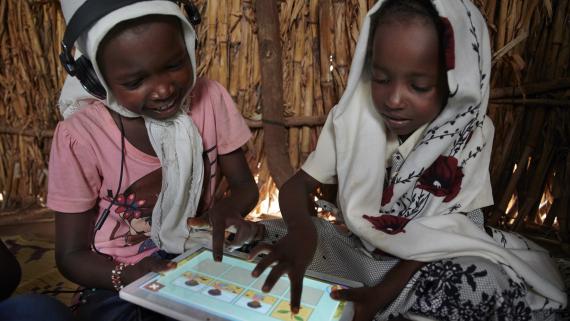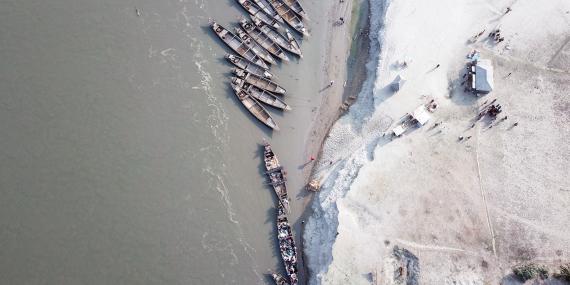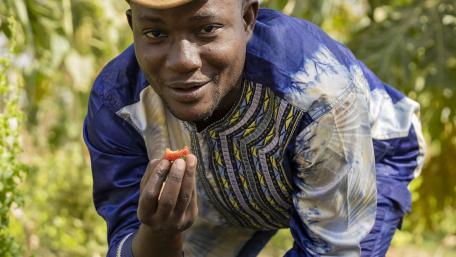Kurigram, Bangladesh
Despite the massive scale of the 2019 floods in Bangladesh, there was limited attention from the global media. An OCHA ROAP communications mission to Kurigram in February 2020 was used to capture the response to the floods six months on from the CERF anticipatory action allocation and to highlight how the CERF-funded humanitarian projects impacted affected people. OCHA
The rate of uptake for digital services has exploded over the last decade. By the end of 2019, the percentage of the global population using the Internet had doubled to 53.6 per cent, or 4.1 billion people, compared to 2009.
There are now more cellular phone subscriptions. Such technology has opened the doors for new practices in humanitarian action, such as conducting real-time surveys and needs assessments over mobile phones or using electronic vouchers for assistance. The potential that new technologies offer to humanitarian action has become even more pronounced during the pandemic: Artificial Intelligence (AI) is being used for outbreak mapping and early warning, screening, diagnosis and treatment. 3D printers are supporting the production of face masks, face shields and ventilators. Drones are delivering medical supplies and testing samples. As many global activities have moved online almost overnight, COVID-19 has brought into focus the state of technological preparedness, digital inequality and business continuity.
Use of internet by gender (2019)
Innovative practices, such as anticipatory approaches and predictive analytics, are also supporting early action in emergencies such as famine, flooding, displacement or disease outbreaks. In 2020, for the first time, OCHA’s Central Emergency Response Fund (CERF) allocated and released funding based on predictive analytics frameworks for famine in Somalia and flooding in Bangladesh (see Pooled Funds and Humanitarian Emergencies for more details).

Kassala, Sudan
Children use their tablet and work with each other at the UNICEF supported Debate e-Learning Centre in a village on the outskirts of Kassala, eastern Sudan. The most efficient technological solutions are demand-driven; they could be “high tech”, “low tech” or “no tech” depending on context and individual circumstances.
UNICEF/Shehzad NooraniAt the same time, the use of technologies in humanitarian settings poses significant risks and challenges to be mitigated. Data and privacy breaches can lead to surveillance, discrimination and persecution of vulnerable populations. Lack of connectivity and digital literacy can widen the “digital divide” and lead to biases and digital discrimination, particularly in the use of AI. Gender biases may intensify due to women’s disproportionate lack of access to technology, such as mobile devices and the Internet.
Mine Action: Communication mechanism for risk education
Mine education is based on awareness and access: without access to people; they may not be aware of the risks associated with mines or adopt safe practices. In Sudan, faced with a context of ongoing conflict, the poor quality of roads and the lack of multilingual risk educators, the UNMAS team has developed a vocal risk education system using solar energy ( RETD). This device uses songs, plays, interviews and a loudspeaker to convey messages about the risks of mines.
UNMASHarnessing the opportunities and mitigating the risks of new and emerging technologies in humanitarian action requires a rights-based approach in accordance with international law, the “do no harm” imperative and humanitarian principles. This approach ensures that basics are in place, such as data protection, privacy and responsibility standards. Investment in connectivity and digital literacy will help bridge digital divides and aid localized approaches, while collaboration with other actors will boost synergies between areas of expertise and save resources. Importantly, technology will be most efficient under demand-driven approaches: the most effective response could be “high tech”, “low tech” or “no tech” depending on context and individual circumstances.
References
- International Telecommunications Union (ITU) Statistics. Data downloaded 27 October 2020.
- CERF, Early funding from CERF as food insecurity in Somalia is projected to rise, 26 June 2020
- Verity and Wright, Artificial Intelligence Principles for Vulnerable Populations in Humanitarian Contexts, Digital Humanitarian Network, January 2020
- ODI, The Humanitarian ‘Digital Divide,’ HPG Working Paper, November 2019
- ITU, Measuring digital development Facts and figures 2019





